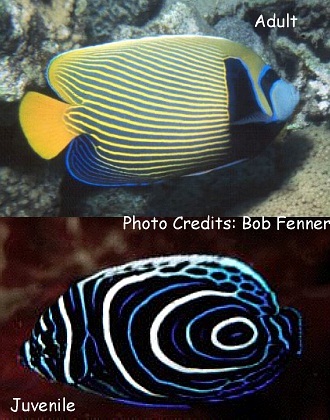
By Bob Goemans

Not Reef Tank Suitable
Likely Fish-Only Tank Suitable
Range: Indian and Western-Central Pacific Ocean: East Africa and Red Sea east to the Philippines, north to Southern Japan and south to the Great Barrier Reef.
Size: 15 inches (38 cm)
Natural Environment: Adults inhabit caves, ledges, reef channels, and reef walls at depths of 10 to 250 feet (3 - 80 m) and reach a length of about 14 inches (35 cm). Juveniles inhabit protected shallow coastal reefs in areas such as in and around lagoon coral heads, and channels in patch reefs, outer-reef flats and outer-reef faces. Subadults occupy fore-reef and surge channel areas. Adults are mainly a benthic feeder, and feed upon sponge, tunicates and some algae. Juveniles are thought to also feed upon the mucus/slime of other fish, such as moray eels. Males form a territory that encompasses the home of two or more females.
General Husbandry: Both the juveniles and adults in this species are quite pretty and are among the most popular with aquarists. As for the juvenile, its body is dark blue and beginning at its tail, bright blue and white circular lines radiate forward onto the body with them becoming more vertical at the head and face. As for the adult, it has a more brilliant blue body with bright yellow horizontal stripes, a whitish mouth and a bright yellow tail. It also has a bluish black mask over the eyes and an arching black vertical band that extends from the pectoral fin upward to about two-thirds of the way up the body with it edged in a brilliant-blue on its front side, and thinly edged in bright yellow on its rear edge.
When first introduced into the aquarium, preferably a well-established fish-only aquarium with lots of live rock and cave areas, adults or juveniles should be offered numerous daily feedings so as to quickly acclimate it to its surroundings. Like many others in this genus, their captive diet should consist of a wide variety of frozen foods including fortified brine shrimp, mysis, and especially those containing sponge matter/angelfish food preparations and continued to be offered at least several times daily after its acclimated to its surroundings. Furthermore, flake foods, and especially those containing Spirulina and/or Nori should be also offered, along with fresh broccoli and macroalgae, as ‘greens’ make up a portion of this species diet, especially the juveniles and subadults.
Depending upon its tankmates, juveniles may be somewhat shy when first entering the aquarium, and may hide in caves and crevices. But as time passes, will become more outgoing and begin to establish its territory. As for adults, those in this genus are considered almost as feisty as those in the Holacanthus genus, nevertheless, it all depends on aquarium size and tankmates, but its preferable it is the last angelfish to be added to the aquarium.
Taxonomy:
Order: Perciformes
Suborder: Percoidei
Family: Pomacanthidae
Genus: Pomacanthus
FYI: Keeping more than one genus of angelfishes in the same aquarium is possible, yet depends upon several aspects. The following suggested circumstances are just that, possibilities that when heeded and adjusted to actual aquarium conditions ‘may’ make multiple angelfish collections feasible.
Aquarium size – the larger the better.
Species from the same genus should not be in the same aquarium.
The smallest and most docile genus species should be the first introduced with the largest and most malicious the last to be added.
Do not place similar coloration species in the same aquarium.
Those already in the aquarium should be well fed before adding a newcomer.
Have sufficient hiding places/rocky caves.
Do not overfeed meaty foods, especially juveniles, as it may lead to a fatty deposit around the liver that could stop production of vitamin A. This could cause blindness, often referred to as nutritional blindness. Furthermore, without sufficient ‘greens’ color loss in this species is quite possible!
Known to produce a low frequency thumping or clicking sound when approached by larger species, including divers.
The male has dark blue in front of the black eye mask. The female has a more light blue-gray color.
Unfortunately, juveniles and some subadults do not always transform into adult coloration in the aquarium.
As noted by Scott Michael in his book titled ‘Angelfishes and Butterflyfishes’ (reviewed on the website saltcorner.com), he states the ‘Emperor Angelfish from the Indian Ocean differs morphologically from most populations in the Pacific. In adults from most of the Pacific, the upper rear edge of the dorsal fin is pointed and develops a long filament as the fish grows, while adults from the Indian Ocean and Red Sea have a rounded dorsal fin with no filament. Theses two forms overlap in distribution around Bali. Individuals from the Line Islands also lack the dorsal filament.’
Keep in mind all angels have cheekspines at the edge of their gill cover; therefore use caution when handling and also avoid using a net to capture it, as it may become stuck or tangled in the net and become damaged when removed.
Experience Level: Intermediate
Temperament: Semi-aggressive
Diet: Omnivore
Acclimation Time: 30 minutes+
Aquarium Environment: Fish-only and Reef Aquariums (See Below)
Reef Safe: Juveniles – Yes/Adults - No - will nip clam mantles, large and small polyped stony (LPS/SPS) corals, and also some soft corals and tubeworms.
Minimum Tank Size: 150 gallons
Temperature Range: 72 - 82°F (22 – 28°C)
Specific Gravity: 1.020 - 1.026
pH: 8.0 - 8.5
